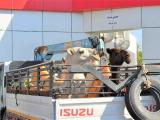Tests on camels and their relatives in Israel, a country that hasn't reported any human MERS-CoV cases, found that although the animals may have been exposed to the virus in the past, there wasn't any sign of active circulation during the study period, according to researchers who looked at blood and nasal swabs collected from 2012 to 2017.
In other MERS-CoV (Middle East respiratory syndrome coronavirus) developments, Saudi Arabia reported another human illness, involving a 66-year-old man who had contact with camels.
Antibody titers lower than in nearby nations
In the camelid study, researchers from Israel and Erasmus Medical Center in the Netherlands said evidence for MERS-CoV in dromedary camels has been reported for nearly all of the Middle East, except for Israel.
Reporting in the journal One Health, they said the dromedary camel population in Israel is thought to range between 3,000 and 5,000, many of them kept by semi-nomadic Bedouin people in the Negev Desert. Also, they said the Negev is home to the largest herd of alpacas and llamas outside of South America.
To look for evidence of past exposure to MERS-CoV, the scientists collected blood samples from 2012 through 2017: 411 from camels, 102 from alpacas, and 19 from llamas. Eighteen of 20 camel farms they visited were in Negev, and the alpacas and llamas were from one farm in Negev.
To look for active circulation, they obtained nasal swabs from 661 camels, alpacas, and llamas from January 2015 to December 2017.
In camels, seroprevalence for MERS-CoV averaged 60.6% over the study period, suggesting that Israeli camels had been exposed to the virus in the past. The proportion of blood samples with high virus neutralizing antibody test (VNT) titer, the gold standard assay for serologic diagnosis of MERS-CoV infection, was 27.3%, which the authors said was much lower than seen in camels in surrounding countries, such as Saudi Arabia, Qatar, the United Arab Emirates, Oman, Egypt, and Jordan.
The blood tests also revealed evidence of MERS-CoV antibodies in alpacas and llamas; two camels housed with the llamas and alpacas were negative for antibodies and viral RNA.
Reverse-transcriptase polymerase chain reaction (RT-PCR) testing on samples from nasal swabs found no evidence of MERS-CoV RNA, ruling out evidence of active virus circulation in the animals.
Taken together, the relatively low antibody prevalence, low antibody titers, lack of viral RNA on nasal swabs, and lack of human infections suggests limited MERS-CoV circulation in Israeli camels during the study period, the authors wrote.
MERS case in Saudi Arabia
Meanwhile, Saudi Arabia continues to report a small but steady stream of MERS-CoV illness, with the latest case involving contact with camels, a frequently reported source of the virus in the country.
The man is from Hofuf, located in the east central part of Saudi Arabia, according to a May 4 report from the country's Ministry of Health (MOH). He is a Saudi citizen, is not a healthcare worker, and is hospitalized in critical condition.
With this new case, Saudi Arabia has reported 1,838 MERS-CoV illnesses, 744 of them fatal. Three people are still being treated for their infections.
See also:
May 4 One Health study
May 4 Saudi MOH report





















